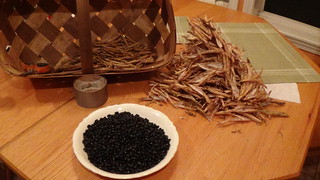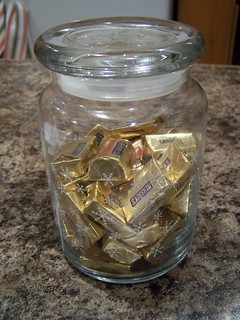As summer winds down the tomatoes ramp up and we’ve got a bountiful harvest coming in. Some we use fresh – in fact we try to enjoy as many as we can fresh – but what to do with the rest?
 Sharing is good: if you have friends and family that don’t raise their own tomatoes. A couple of Sundays ago we went to church and found a large basket of ripe, red tomatoes sitting inside the door. From the pulpit, the pastor clarified, “Those tomatoes inside the door are for taking home and eating, not for throwing at your pastor.”
Sharing is good: if you have friends and family that don’t raise their own tomatoes. A couple of Sundays ago we went to church and found a large basket of ripe, red tomatoes sitting inside the door. From the pulpit, the pastor clarified, “Those tomatoes inside the door are for taking home and eating, not for throwing at your pastor.”
Tomato season doesn’t last long so it’s a good idea to preserve what you don’t eat or give away for use later. Here are my favorite ways to preserve tomatoes to be enjoyed throughout the year.
Freezing
Tomatoes freeze well and it’s easy to do. Freezing does make the skins tough, so you can blanch the tomatoes in boiling water for 30 second to get the skins to slip off easily, but I prefer not to. I remove the core, cut the tomato in half along the equator, use a plastic spoon to scoop it the seedy-goopy stuff (that does not freeze well) then cut the tomato halves into wedges. Lay the wedges skin side down on a cookie sheet and pop in the freezer. When the wedges are frozen stiff, quickly transfer them into a freezer bag and put it back into the freezer. When the bag is full, squeeze out as much air as possible and seal the bag before putting it into the deep freeze.
By freezing the wedges individually you will be able to take out and thaw just what you need and put the rest back, still frozen. If you throw a whole bunch of wet tomatoes in a bag and freeze them as a unit, the whole bag will have to be thawed to be used. This is not a problem if you have specific uses in mind and package according to your intended use. If not, versatility without waste is good.
When you thaw the wedges the skins will pull off easily.
Dehydrating
 Dried tomatoes can be enjoyed directly as a crunchy snack (tomato chips) or can be stored for long terms to be used in cooking.
Dried tomatoes can be enjoyed directly as a crunchy snack (tomato chips) or can be stored for long terms to be used in cooking.
Remove the core, slice the tomato in half along the equator and use a plastic spoon to remove the seeds and goop.
Tomatoes can be dried with the seedy goop left in, but it will take a lot longer and you risk scorching the tomato flesh. Slice the tomato halves into rings ¼” thick for “chips” ½” thick for storage.
Spray the tray of your dehydrator with non-stick cooking spray (or rub with olive oil). If you don’t have a dehydrator you can use cake cooling racks on cookie sheets in your oven set at its lowest temperature (and even at that you may need to crack the door). For a dehydrator, 140° works well. Be sure to rotate the drying trays (or cookie sheets) around the oven to produce even drying.
When the slices are leathery, flip them over and continue until they are dry. Store in an air-tight jar, or vacuum pack them.
To use in cooking, soak the slices in hot water to reconstitute. If you’re making soup, the liquid in the soup will do this for you.
Instant Tomato
Another angle of dehydrating is to keep the skins you remove from tomatoes you process in other ways, dry those then use a mini-food processor or grinder to pulverize the dry skins into powder. This “instant tomato” can be used as a tomato flavored thickener or can be mixed with a little water to make tomato paste.
Canning
Canning tomatoes can be a little time consuming, but it’s not hard to do. They can be pressure canned, if you have that equipment, or water bathed. You can put them up as sauce, or soup, as tomato chunks, or whole: plain or pickled. Recipes abound. My favorite way to can raw tomatoes is what’s called Raw Pack Canning.
Raw Pack Canning
 The tedious part is preparing the tomatoes. I tend to do this when I get about a half-bushel of tomatoes – this will yield a full canner run of 10 pint jars. But that’s a lot of tomatoes to clean.
The tedious part is preparing the tomatoes. I tend to do this when I get about a half-bushel of tomatoes – this will yield a full canner run of 10 pint jars. But that’s a lot of tomatoes to clean.
Blanch the tomatoes in boiling water for 30 seconds, then drop into icy cold water to arrest the cooking process. Core, slip the skins, and remove the seeds.
Chop the tomato into whatever size chunks you tend to use. If you want very small chunks, drop the tomatoes into a food processor and pulse just enough to chop them. Put the cut tomatoes in a colander to drain off as much water as possible (this helps reduce separating that produces a half-jar of tomatoes floating atop a half jar of clear liquid).
While you are doing this, have a canner full of jars & lids boiling up.
Some folks say that if you’re going to can something for more than 10 minutes you don’t need to boil the jars and lids to sterilize them, they’ll be sanitized in the canning process just like the contents; just wash them well and rinse. Others say always sterilize the jars. If I’m going to err, I prefer to err on the side of caution: especially if an error could make my family sick or dead. So I always boil up my jars and keep them hot in the canner.
Remove a jar from the canner with tongs or a jar lifter, dump the hot water in the jar into the sink (unless you’ve boiled your water level in the canner down, then dump a little of the hot water into the canner first). Put a tablespoon full of lemon juice in the bottom of a pint jar (2 Tbsp. for a quart – don’t use the 1½ quart jars for raw-pack) and spoon in enough tomato chunks to half-fill the jar. Use a non-reactive spoon or pestle, or something (I uses a small stainless steel whisk) to smoosh the tomatoes down. This forces out air pockets and fills gaps with juice. Air pockets are bad. Fill the jar almost full and do it again. Now inspect the jar for air bubbles that might have been missed and remove them with a plastic or bamboo utensil (I use an orange peeler). Top the jar to leave ½” of head space, wipe the rim, install a lid and band (just finger tight) and return the jar to the canner.
Repeat until all the jars are filled.
To water bath these you’ll need to boil the full jars for 85 minutes. Adjusting for altitude means I have to water bath the batch for about two hours! To me it makes a whole lot more sense to pressure can raw-pack tomatoes … especially since I DO have a good pressure canner. That means venting steam for ten minutes to purge the canner, install the 10 pound weight and process at 10 pounds for 15 minutes. Low altitudes can go 10 pounds for 10 minutes. Then turn it off and go do something else while it cools down. A half-hour instead of being stuck watching the pot boil for 2 hours.
Cooked Tomatoes
 My favorite way to put up cooked tomatoes is to make sauce out of them.
My favorite way to put up cooked tomatoes is to make sauce out of them.
Blanch, peel, core and clean the tomatoes as above.
If you’re a purist, run them through a food mill. If not, use a food processor to pulse the tomatoes for a fine chop and transfer this to a stainless steel stock pot on medium-high heat. Simmer, stirring frequently, until the tomato mixture is reduced in volume by half. Reduce heat just to keep it hot.
For an Italian sauce add to each prepared pint jar: (double this for quarts)
- 1 fresh Basil leaf
- ½ tsp Thyme
- ½ tsp Oregano
- ¼ tsp Rosemary
- ¼ tsp Sage
- ½ clove Garlic (smashed)
- ¼ tsp Onion powder
- 1 Tbsp. Lemon juice
By measuring the spices into each jar instead of into the stock pot you get a more consistent taste across the batch – and you can adjust or eliminate the spices if you desire to do a split batch. I also like to put up sauce with BBQ seasoning and with Chili seasonings. These make quick meals possible.
The lemon juice is required as an acidifier, anything else can be adjusted.
Ladle your cooked tomato into the hot jars, leaving 1/2” head space. Remove bubbles (recheck head space), wipe the rim, install a lid and band (finger tight) and return to the canner. Water bath the batch for 35 minutes (adjust for altitude).
There You Have It
By having tomatoes put up in a variety of ways we have options. By having some put up as pre-seasoned tomato sauce we have an easy open-and-go means of fixing dinner. By having the raw pack canned tomatoes we have versatility. Frozen tomatoes retain more texture. Dried tomatoes are compact and last a long time. You can transfer some from glass jars to vacuum packed bags to take along on camping trips for better-than-average meals in the wild.
Maybe you won’t be able to do BLT’s in January with your own tomatoes, but most anything else can be created from at least one of these forms of preserved tomatoes. Enjoy!






 I got nine pints from that basket of apples. Yes, I can count: one didn’t seal and it’s in the refrigerator. I probably forgot to wipe the rim. By the time I got to the canning run it was getting late and Marie would be home soon and I was rushing.
I got nine pints from that basket of apples. Yes, I can count: one didn’t seal and it’s in the refrigerator. I probably forgot to wipe the rim. By the time I got to the canning run it was getting late and Marie would be home soon and I was rushing.


 Each American consumes a yearly average of 23.2 quarts of ice cream, ice milk, sherbet, ices and other commercially produced frozen dairy products.
Each American consumes a yearly average of 23.2 quarts of ice cream, ice milk, sherbet, ices and other commercially produced frozen dairy products. I love dark chocolate. Yes, I know: to most of you this qualifies me as a psychopath. “Normal” people prefer the sweetness of milk chocolate. Be that as it may, I remain committed to the dark variety. But then, even though I’m a Southerner, I don’t drink Sweet Tea and I prefer the taste of a diet soda over regular just because I can’t handle the syrupy sweetness. In the meals that we cook we reduce or eliminate sugar. It’s what we’re accustomed to.
I love dark chocolate. Yes, I know: to most of you this qualifies me as a psychopath. “Normal” people prefer the sweetness of milk chocolate. Be that as it may, I remain committed to the dark variety. But then, even though I’m a Southerner, I don’t drink Sweet Tea and I prefer the taste of a diet soda over regular just because I can’t handle the syrupy sweetness. In the meals that we cook we reduce or eliminate sugar. It’s what we’re accustomed to.